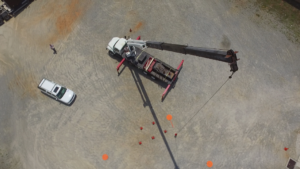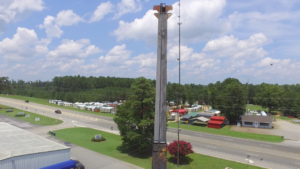Crane Training, Inspections Take Advantage of Latest Tech Tools
Crane operation relies on constants—principles of gravity, force, and leverage have been the same since the beginning of time. But technology is reshaping crane training and offering new tools for crane operations. Drones, simulators and other tools are rapidly moving from military exercises to commercial construction applications.
If you doubt how quickly the landscape is changing, the 75,000 sq. ft. Tech Experience exhibit dedicated to new construction technologies at the 2017 ConExpo-Con/Agg show should be evidence enough. A year ago, Crane Industry Services embarked on a study with CM Labs Simulations Inc. and West Georgia Technical College to determine the value of simulators in crane training. More recently, they began assessing the use of drones for use in crane training, crane inspections, and lift planning.
Sim study update
“We are finding that 8 hours in a crane simulator is equivalent to 30-40 hours in the field. There is so much more that you can pack into a condensed training time when teaching crane operators new skills or lifting scenarios,” said Debbie Dickinson, CEO of Crane Industry Services. While the study is ongoing, the company recently launched a custom crane simulator training program for a utility company. The objectives were skill-based training, documentation of training, and measurements of skills achieved. Simulators help to bridge the skills gap. “More seasoned employees are leaving the industry than new people are entering and we are losing a tremendous body of knowledge,” said Dickinson. “Simulators are being used by employers for strategic workforce development,” she said.
Shawn Galloway, CIS Instructor, worked with Dickinson and the utility to create a simulator training protocol, called CIS Skills Measurement Record TM. Galloway has previous experience writing training protocols for unmanned aerial vehicle operations in the military, including drone tactical standards for the U.S. Army, Navy, Air Force, and Marines.
Galloway is applying this experience to the development of the Skills Measurement Record for simulators in crane training. “First, we identify the most common skills needed, and the most critical skills. We build scenarios for the simulator based on that and write curriculum, evaluations, and metrics to measure performance specific to the utility company’s training needs,” he explained. While the protocol would be customized to each employer and the skill level of employees, it provides a foundation for establishing how much simulator training is needed to achieve a certain skill level.
Just as the aviation industry has standards for how much training (both simulated and real) is necessary for pilots to maintain proficiency, CIS’s long-term goal for its research with crane simulators is similar. “The industry uses simulators. CIS is working to provide valid research that is useful to employers, simulator developers, and possibly standards-writing bodies for setting guidelines,” said Dickinson.
Drones and cranes

CIS uses drone technology to literally capture the big picture. Notice the small orange cone in the lower right corner? From that point it is 20 feet to a power line. Enough said.

In congested areas were laying the boom down is impossible, the CIS inspector took a close look at the working boom.
Meanwhile, the crane training and inspection company is now exploring uses for drones as part of their services. In crane operator training, overhead video shows the boom’s route through a course. “For example, teaching an operator awareness of powerlines and how to maintain control of the boom and load while maintaining proper distances is difficult to judge at ground level. By using a drone to video the activity from above, it’s much easier to see how close the crane came to the required perimeter,” said Cliff Dickinson, President of CIS, who is a licensed pilot.
In work environments, drones can be used to assist with post-assembly crane inspections. “These typically take place in congested environments, where it’s not possible to lay a boom down,” said Cliff Dickinson. A drone helps an inspector see the condition of components, wire rope, or the reeving over the sheaves on the boom tip.
Drones may also be useful in lift planning to double check the crane configuration and expected load travel route. Conditions on a job site change frequently. While the lift may have been pre-planned and even simulated in software applications, a drone can be flown in the expected crane or load travel pattern to make sure there are not unanticipated obstacles. “It’s a real-time comparison with a lift plan to confirm access/egress,” said Debbie Dickinson.
CIS’s endeavors mirror the shift in construction education. A new course at Georgia Institute of Technology’s School of Building Construction is teaching students how to apply a variety of technologies to construction tasks. In April 2017, Equipment World reported that the course, CONECTech, is teaching “how to integrate technology into the workflow and how to use it in a way that is functional on a jobsite.”
“When we teach students about technology, it changes so quickly we try not to focus on the gadgets so much, but on the application of the data that they extract,” said Javier Irizarry, director of CONECTech.
“It’s always important that the students understand the goals of the jobsite and its managers first and foremost.”
CIS is in talks with Georgia Tech to collaborate on developing simulator training protocols and drone applications for the crane and rigging industry. Both Irizarry and Debbie Dickinson serve on the AGC Georgia Safety Forum and plan to reach out to AGC Georgia members for participation in future research projects.
